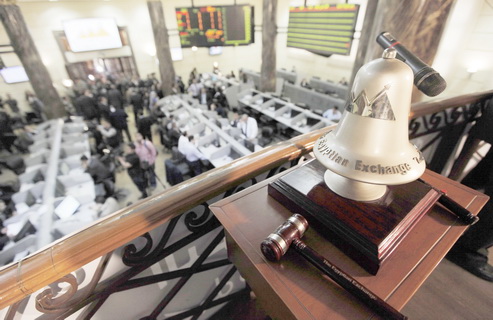One year after Egypt floated its currency, foreign investors are back to the market after years of turmoil, as cheap stocks’ valuation served as a boost to lure foreign investors seeking profitability and high yields on their investments.
According to bourse data and Daily News calculations, EGX30, the main benchmark index, has rallied 63% in 12 months following the devaluation date.
On 3 November, Cairo’s main gauge was hovering around 8,810.15 points, against 14,300 points by the end of Tuesday’s session, an increase of about 5,555 points.
Last November, Egypt took the dramatic step of allowing its currency to trade freely as it announced measures to stabilise an economy crippled by a dollar shortage that has raised concerns about social unrest.
Stocks jumped the most in eight years, and the pound slumped after the central bank’s decisions, which included raising its two benchmark overnight interest rates by three percentage points.
They came after months of negotiations with the International Monetary Fund over a $12bn loan that’s seen as crucial in western capitals to preventing an economic meltdown that could destabilise the most populous Arab country.
Egypt, widely considered a frontier market, is gaining popularity among foreign investors.
The country holds a place in the Goldman Sachs list of the “Next Eleven” economies, and has the potential to overtake many of the G20 nations.
A recent report issued by Fontera Resrarch said that foreign investors seeking exposure in Egypt could invest in ETFs that offer diversification through investment in a single US security.
Alternatively, investors wanting direct exposure could consider ADRs of Egyptian companies listed on US Stock exchanges.
The most popular ETF for US investors is the Market Vectors Egypt Index ETF (EGPT). With assets under management of $57m, it offers concentrated exposure to companies that derive at least 50% of their revenues from Egypt.
Financials is the top sector with 34% of assets, followed by telecommunications, basic materials, and consumer non-cyclicals.
The fund is up 26% over the last one-year period. Investors could also consider investing in the WisdomTree Middle East Dividend Fund (GULF) or the VanEck Vectors Africa Index ETF (AFK). These funds invest 4.5% and 9.7% of their holdings in Egypt-based companies. YTD these ETFs have gained 9% and 0.6%, respectively.
A number of Egyptian companies are listed on the New York Stock Exchange in the form of ADRs. They provide a much easier way for investors to buy Egyptian stocks, with fewer risks related to liquidity.
Monetary policy limits gains
Egypt’s stock markets (EGX30) plunged after the Central Bank of Egypt (CBE) raised key interest rates in a surprise move.
This move is a result of the IMF’s statement saying Egypt should focus on curbing inflation.
Jason Tuvey, Middle East economist at London-based Capital Economics, mentioned that raising interest rates “appears to be the result of pressure from the IMF.” However, analysts expect the correction to be temporary.
Cairo’s Naeem Brokerage stated, “While we expect a market-wide correction as an immediate reaction to the increased opportunity cost of capital, the impact should be felt more on companies that are excessively leveraged.”
Last year, S&P Global raised its outlook on Egypt (EGPT) from negative to stable after the country floated its currency.
In a report to investors, S&P stated, “We are revising our outlook on Egypt to stable from negative and affirming our ‘B-/B’ long and short-term sovereign credit ratings on the country. The stable outlook balances Egypt’s external and fiscal vulnerabilities, against likely IMF support following the government’s upfront delivery on programme reforms.”
Analyst ratings
Analysts from different research house estimates tend to drive short-term movements of stocks. Changes in ratings and estimates guide investors towards what markets are expecting from a particular company.
Analysts are most bullish on Centamin (CEY), Six of October Development, and TMG Holdings (TMGH), as these stocks have received the highest buy ratings, and few sell ratings.
Analysts are most bearish on EZZ Steel (ESRS.CA), Juhayna Food Industries (JUFO.CA), and Elswedy Electric, as these stocks have received the highest number of sell ratings.
EZZ Steel has received four buy ratings, four hold ratings, and four sell ratings, while Juhayna Food Industries has received six buy ratings, three sell ratings, and five hold ratings.
Elswedy Electric has received seven buy ratings, three hold ratings, and two sell ratings.
Egypt is turning out to be the second most popular stock market in the Middle East for foreign investors this year, just behind Saudi Arabia, according to a recent report by Goldman Sachs.
Investors see growth potential in Egypt given heavy investments coming into the country through China’s ambitious One Belt One Road project.
According to the report, Egypt’s benchmark index – the EGX30 Index (EGX30.CA) currently trades at a one year forward price to earnings multiple of 11.7x. In the last 12 months, this index is up 61%, but investors believe Egypt’s market is still attractively priced.
Shakeel Sarwar, head of asset management at Securities & Investment Co in Bahrain, stated, “In terms of valuations, it looks more attractive. “Growth prospects of Egypt’s economy are much stronger than those of the Gulf economies.”
He added, “Going forward, if I take a one-year view, Egypt is likely to offer better returns.”
To identify the attractively valued Egyptian stocks, we studied the holdings of the Market Vectors Egypt Index ETF (EGPT). Amer Group Housing (AMER), Emaar Misr (EMFD) and Telecom Egypt (TEEG.IL) are currently trading at inexpensive valuations compared to their peers.
They have one year forward price to earnings multiples of 3x, 4.5x, and 4.9x, respectively.
Related Article 4 Mexico Stocks Hit Hardest By Souring NAFTA Negotiations
Meanwhile, Heliopolis Housing (HELI), EFG Hermes Holdings (HRHO.CA), and Medinet NASR Housing (MNHD.CA) are noticeably expensive. They have PE multiples of 39.7x, 31.8x, and 21x, respectively.
Generally, stocks trade at an average price to earnings ratio of 20-25x.
Stocks trading lower than their average price to earnings multiples or lower than the sector average price to earnings multiples attract investor attention because they’re considered inexpensive.
The price to earnings multiple compares a stock’s price to its forward earnings per share.
If a company trades at a high PE, it means investors are anticipating higher growth in the future.
The country is also included in Goldman Sachs’ list of “Next Eleven” economies that have the potential to overtake some of the G20 nations.
Investments have been flowing into the country since the central bank floated its currency last year and raised interest rates to cut short a shortage in foreign exchange dollars. The country also secured a $12bn loan from the IMF. To curb inflation, the central bank raised interest rates last week.
In November 2016, the country free floated its currency to boost its foreign reserves. “After the devaluation, we became bullish on Egypt,” said Akhilesh Baveja, lead portfolio manager for the Charlemagne Magna Mena fund.
Most asset managers are bullish on investments in consumer stocks and private sector banks.
Many also regard the debt markets as attractive.
Potential risks
But despite the positive outlook, analysts caution that the current upswing may not be sustainable.
Potential risks of investing in Egypt’s stock market are the risk of militant violence and corrupt bureaucracy.
Crispin Hawes, managing director at Teneo Intelligence, thinks Egypt’s gains are short lived.
In a recent statement, he mentioned, “The economy is better now than at any point in the past five years, but there is little reason to believe it can be maintained.”







